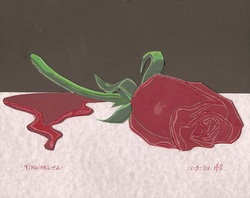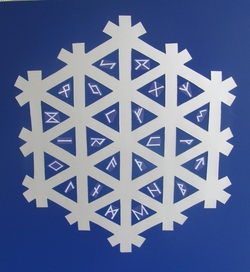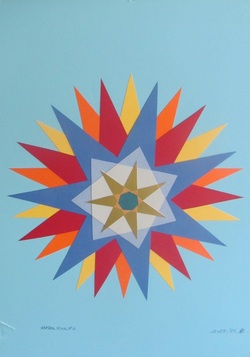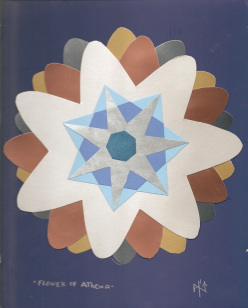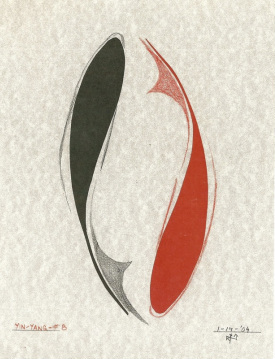Paper Montage
Paper montage, the use of cut pieces of paper arranged and pasted onto a larger background paper sheet or board, was probably first made notable as an art form by the French artist Henri Matisse. Matisse, if memory serves me, was for some reason bedridden when he first began his paper montage works. He sat up in bed with scissors in hand cutting the shapes he wanted out of colored paper and pasting them in such a way as to create his desired image.
My own use of the paper montage technique was the outgrowth of two factors: I had been creating a small number of poetry chapbooks and putting dust jackets on them made from a heavy craft paper. The craft paper was in twelve-inch squares. There was always excess paper when I was done with the book covers. For some reason I saved all of these scraps since it was both expensive paper (running about a dollar per square) and it also had very nice texture and colors. So I saved a stack of this paper in a small wooden tray not really knowing what use I would put it to.
One day I awoke and discovered that the lower half of my right eye was swollen. When I tried to draw, my eye began to tear. Before long I gave up trying. Somehow it came to me to revert to the simple art of paper montage. Most of us will recall such a rudimentary method from grammar school. It’s something they do before moving on to pencils. So simple a method suited my purpose in light of my vision malaise. It was far less a strain cutting out large sections of colored paper than it was doing formal drawing and coloring with Prisma pencils.
The first montage I did was that of a gauntlet glove holding a long-stemmed rose aloft. It was very simple in construction as all montages must be by virtue of the technique. One must simplify the image. In simplifying the image it has a very symbolic effect. That rose was to go on from being a small montage in a simple frame on my wall to the cover graphic of a Changes album cover (Hero Takes His Stand ) as well as a Changes t-shirt design where I think it worked equally well.
So began my paper montage period. Over the ensuing months I was to do a large number of such works. Each time I was trying to do something a bit more ambitious than the preceding work. Such is often the way of artists.
I did a large montage of two butterflies coupling, a dragon’s head and many other works. I did some montages using transparent vellum or tissue papers. I began a series of montages of hearts, treskles and other symbols. For simple stark subjects it worked best. For graphic art, t-shirts, album cover art, logos, etc., it makes for simple, bold designs.
My principal manner of gluing the paper was to use a hot-wax roller applicator. Several years ago mine broke and none were available any longer from suppliers (probably as a result of computer graphics largely supplanting actual paste-up). The roller applicator made it easy, whereas other pasting methods are a lot messier and less dependable. I probably created well over a hundred works employing paper montage.
R. N. Taylor
January 2011
My own use of the paper montage technique was the outgrowth of two factors: I had been creating a small number of poetry chapbooks and putting dust jackets on them made from a heavy craft paper. The craft paper was in twelve-inch squares. There was always excess paper when I was done with the book covers. For some reason I saved all of these scraps since it was both expensive paper (running about a dollar per square) and it also had very nice texture and colors. So I saved a stack of this paper in a small wooden tray not really knowing what use I would put it to.
One day I awoke and discovered that the lower half of my right eye was swollen. When I tried to draw, my eye began to tear. Before long I gave up trying. Somehow it came to me to revert to the simple art of paper montage. Most of us will recall such a rudimentary method from grammar school. It’s something they do before moving on to pencils. So simple a method suited my purpose in light of my vision malaise. It was far less a strain cutting out large sections of colored paper than it was doing formal drawing and coloring with Prisma pencils.
The first montage I did was that of a gauntlet glove holding a long-stemmed rose aloft. It was very simple in construction as all montages must be by virtue of the technique. One must simplify the image. In simplifying the image it has a very symbolic effect. That rose was to go on from being a small montage in a simple frame on my wall to the cover graphic of a Changes album cover (Hero Takes His Stand ) as well as a Changes t-shirt design where I think it worked equally well.
So began my paper montage period. Over the ensuing months I was to do a large number of such works. Each time I was trying to do something a bit more ambitious than the preceding work. Such is often the way of artists.
I did a large montage of two butterflies coupling, a dragon’s head and many other works. I did some montages using transparent vellum or tissue papers. I began a series of montages of hearts, treskles and other symbols. For simple stark subjects it worked best. For graphic art, t-shirts, album cover art, logos, etc., it makes for simple, bold designs.
My principal manner of gluing the paper was to use a hot-wax roller applicator. Several years ago mine broke and none were available any longer from suppliers (probably as a result of computer graphics largely supplanting actual paste-up). The roller applicator made it easy, whereas other pasting methods are a lot messier and less dependable. I probably created well over a hundred works employing paper montage.
R. N. Taylor
January 2011





